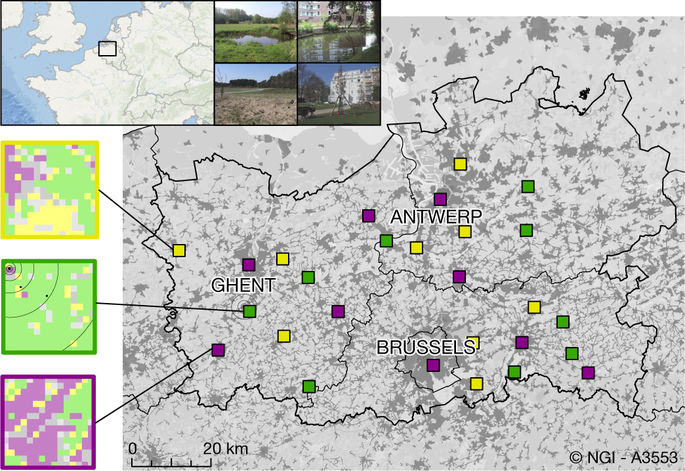Our official English website, www.x-mol.net, welcomes your
feedback! (Note: you will need to create a separate account there.)
Body-size shifts in aquatic and terrestrial urban communities
Nature ( IF 50.5 ) Pub Date : 2018-05-23 , DOI: 10.1038/s41586-018-0140-0 Thomas Merckx , Caroline Souffreau , Aurélien Kaiser , Lisa F. Baardsen , Thierry Backeljau , Dries Bonte , Kristien I. Brans , Marie Cours , Maxime Dahirel , Nicolas Debortoli , Katrien De Wolf , Jessie M. T. Engelen , Diego Fontaneto , Andros T. Gianuca , Lynn Govaert , Frederik Hendrickx , Janet Higuti , Luc Lens , Koen Martens , Hans Matheve , Erik Matthysen , Elena Piano , Rose Sablon , Isa Schön , Karine Van Doninck , Luc De Meester , Hans Van Dyck
Nature ( IF 50.5 ) Pub Date : 2018-05-23 , DOI: 10.1038/s41586-018-0140-0 Thomas Merckx , Caroline Souffreau , Aurélien Kaiser , Lisa F. Baardsen , Thierry Backeljau , Dries Bonte , Kristien I. Brans , Marie Cours , Maxime Dahirel , Nicolas Debortoli , Katrien De Wolf , Jessie M. T. Engelen , Diego Fontaneto , Andros T. Gianuca , Lynn Govaert , Frederik Hendrickx , Janet Higuti , Luc Lens , Koen Martens , Hans Matheve , Erik Matthysen , Elena Piano , Rose Sablon , Isa Schön , Karine Van Doninck , Luc De Meester , Hans Van Dyck

|
Body size is intrinsically linked to metabolic rate and life-history traits, and is a crucial determinant of food webs and community dynamics1,2. The increased temperatures associated with the urban-heat-island effect result in increased metabolic costs and are expected to drive shifts to smaller body sizes3. Urban environments are, however, also characterized by substantial habitat fragmentation4, which favours mobile species. Here, using a replicated, spatially nested sampling design across ten animal taxonomic groups, we show that urban communities generally consist of smaller species. In addition, although we show urban warming for three habitat types and associated reduced community-weighted mean body sizes for four taxa, three taxa display a shift to larger species along the urbanization gradients. Our results show that the general trend towards smaller-sized species is overruled by filtering for larger species when there is positive covariation between size and dispersal, a process that can mitigate the low connectivity of ecological resources in urban settings5. We thus demonstrate that the urban-heat-island effect and urban habitat fragmentation are associated with contrasting community-level shifts in body size that critically depend on the association between body size and dispersal. Because body size determines the structure and dynamics of ecological networks1, such shifts may affect urban ecosystem function.The urban-heat-island effect drives community-level shifts towards smaller body sizes; however, habitat fragmentation caused by urbanization favours larger body sizes in species with positive size–dispersal links.
中文翻译:

水生和陆地城市社区的体型变化
体型与代谢率和生活史特征有着内在的联系,并且是食物网和群落动态的关键决定因素 1,2。与城市热岛效应相关的温度升高导致代谢成本增加,预计将推动向更小的体型转变3。然而,城市环境的另一个特点是栖息地严重破碎 4,这有利于移动物种。在这里,我们使用跨十个动物分类群的重复空间嵌套抽样设计,表明城市社区通常由较小的物种组成。此外,虽然我们显示了三种栖息地类型的城市变暖以及四种分类群的相关社区加权平均体型减小,但三种分类群显示出沿城市化梯度向更大物种的转变。我们的结果表明,当大小和扩散之间存在正协变时,通过过滤较大的物种来推翻小型物种的总体趋势,这一过程可以缓解城市环境中生态资源的低连通性5。因此,我们证明了城市热岛效应和城市栖息地破碎化与体型的对比社区水平变化相关,后者严重依赖于体型和扩散之间的关联。由于体型决定了生态网络的结构和动态1,这种变化可能会影响城市生态系统功能。城市热岛效应驱动社区级向更小的体型转变;然而,城市化造成的栖息地破碎化有利于具有正大小 - 扩散联系的物种更大的体型。
更新日期:2018-05-23
中文翻译:

水生和陆地城市社区的体型变化
体型与代谢率和生活史特征有着内在的联系,并且是食物网和群落动态的关键决定因素 1,2。与城市热岛效应相关的温度升高导致代谢成本增加,预计将推动向更小的体型转变3。然而,城市环境的另一个特点是栖息地严重破碎 4,这有利于移动物种。在这里,我们使用跨十个动物分类群的重复空间嵌套抽样设计,表明城市社区通常由较小的物种组成。此外,虽然我们显示了三种栖息地类型的城市变暖以及四种分类群的相关社区加权平均体型减小,但三种分类群显示出沿城市化梯度向更大物种的转变。我们的结果表明,当大小和扩散之间存在正协变时,通过过滤较大的物种来推翻小型物种的总体趋势,这一过程可以缓解城市环境中生态资源的低连通性5。因此,我们证明了城市热岛效应和城市栖息地破碎化与体型的对比社区水平变化相关,后者严重依赖于体型和扩散之间的关联。由于体型决定了生态网络的结构和动态1,这种变化可能会影响城市生态系统功能。城市热岛效应驱动社区级向更小的体型转变;然而,城市化造成的栖息地破碎化有利于具有正大小 - 扩散联系的物种更大的体型。











































 京公网安备 11010802027423号
京公网安备 11010802027423号